10 Best Low-Fat Cheeses For Weight Loss
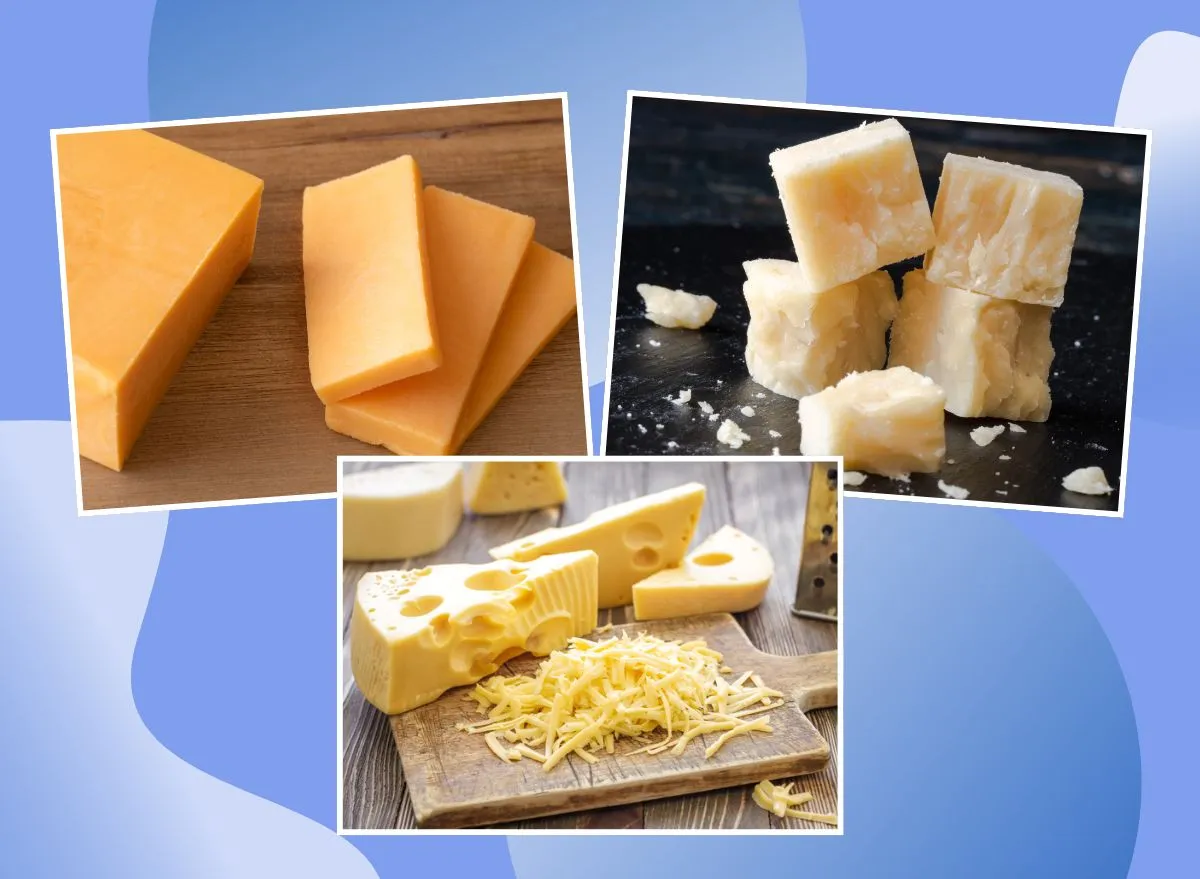
Cheese is one of those foods that makes everyone happy. Unless you have to give it up for health reasons or allergies, most people can't imagine saying no to pizza, mac and cheese, or an elaborate charcuterie board. And honestly, you shouldn't have to! However, if you're trying to lose weight or have set similar health goals, you may be cautious about your cheese intake. Many types of cheese are high in fat and calories, which may hinder your weight loss efforts. Fortunately, the solution is as simple as finding some low-fat cheeses you enjoy.
In this article, we'll start off by defining what low-fat cheese is, how it can support weight loss, and provide a list of the best low-fat cheeses.
What is Low-Fat Cheese, and What Are the Pros and Cons?
Low-fat cheese is a type of cheese that has had fat removed during processing. As a result, it has a lower fat content than regular cheese and contains 2% milk fat or less. Low-fat cheese offers a healthier alternative for those who want to lower their fat intake without completely giving up cheese.
"Low-fat cheese allows people to modify their diet for better health but still enjoy delicious flavor and a favorite food," says Isabel Maples, MEd, RDN, registered dietitian nutritionist. "Cheese is loved by itself, paired with other foods, or in recipes. People might choose low-fat cheeses to lower their fat intake, boost their protein intake, or simply cut calories."
Benefits of low-fat cheese
- Less saturated fat. Low-fat cheeses remove a lot of the saturated fat that's naturally in them. "Saturated fat is known to raise our cholesterol levels," says Sammi Haber Brondo, MS, RD, CDN, registered dietitian nutritionist, and author of The Essential Vegetable Cookbook. "Limiting this type of fat and replacing it with healthy, unsaturated fats (like avocado, olive oil, nuts, and seeds) can be a really healthy swap."
- Lower in calories. Less fat also means fewer calories per serving, aiding weight management. It also helps you reduce overall caloric intake without sacrificing protein.
- Nutrient-rich. Low-fat cheese still provides you with most of the beneficial nutrients found in cheese, like protein and calcium.
Cons of low-fat cheese
- Less flavor. Less fat often means less flavor. Reducing the fat in cheeses often results in a less palatable texture. They can be too hard, gummy, or chewy, affecting both flavor and the cooking experience.
- Potentially more additives. "Fat is usually replaced with some kind of binder to make the texture of the low-fat cheese still work," says Haber Brondo. "While the binder is usually totally safe and no big deal, these cheeses also might not taste as good."
Can Eating Low-Fat Cheese Help You Lose Weight?
Eating low-fat cheese alone won't cause weight loss, but incorporating it into a balanced diet can contribute to a lower overall calorie intake and higher protein consumption, both of which are beneficial for weight management.
- Helps reduce calorie intake. Low-fat cheese can aid in weight loss by reducing the number of calories consumed during meals and snacks. "Low-fat cheese can help one lose weight—but theoretically, any food can," says Maples. "Total calorie intake must be lower than what a person normally consumes to allow for weight loss, so substituting low-fat cheese may do the trick to lower one's calories."
- Boosts protein intake. Cheese is a good source of protein. Low-fat cheese generally contains a similar amount of protein as full-fat cheese, offering a nutrient that aids in satiety and muscle maintenance. "Protein foods are digested more slowly, so they can be more physically satisfying," says Maples. "And as people cut calories, adding a protein-heavy food like low-fat cheese can help hold off hunger without adding too many calories."
- Maintains nutrient intake. Low-fat cheese provides essential nutrients such as calcium and vitamins, which are important for overall health and may support weight loss. One Nutrition Journal study found that vitamin D3 and calcium supplementation in those with low levels of each supported body fat and visceral fat loss.
How to eat cheese and stick to your weight loss goals
A few tips for eating cheese when you want to lose weight:
- Pick a strong cheese. "A strong cheese can help add flavor without going overboard on calories (because you can add flavor with a smaller portion)," says Maples. "Examples include sharp cheddar instead of Colby jack on a sandwich or in a casserole. Or, blue cheese versus American cheese on a salad."
- Go with freshly grated cheese. "Grated cheese can stretch flavor further," says Maples. "That's why grated cheese (like Parmesan or Romano) is a good choice—a little really goes a long way." For example, 1 tablespoon of grated parmesan cheese has 21 calories and a little over just one gram of fat.
- Focus on portions: Cheese is naturally calorie-dense, so even lower-fat options can still have more calories than other snacks. When making your snacks, stick to the serving size.
10 Low-Fat Cheeses, Ranked from Highest to Lowest Amount of Fat
The following low-fat cheeses all have 10 grams or less of total fat per serving, and they are listed in ascending order, ending with the lowest-fat cheese. Read on to see 10 common lower-fat cheeses, then check out 50 Healthiest Weight Loss Snacks on Grocery Shelves.
Ricotta (Part-Skim)
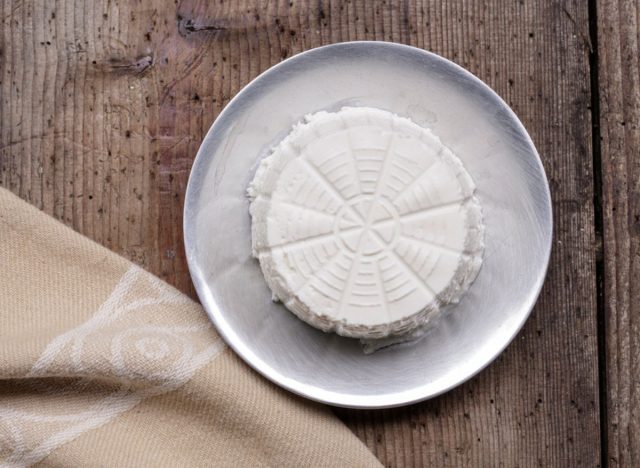
Calories: 171
Fat: 10 g (Saturated Fat: 6 g)
Sodium: 123 mg
Carbs: 6 g (Fiber: 0 g, Sugar: <1 g)
Protein: 14 g
Ricotta is a popular Italian whey cheese that is smooth, creamy, and versatile. It can be used in sweet recipes like cannolis and cheesecake or in more savory dishes like lasagna or pasta. In a 1/2-cup serving, you get 10 grams of fat and only 6 grams of saturated fat, so it's considered a low-fat cheese.
Swiss
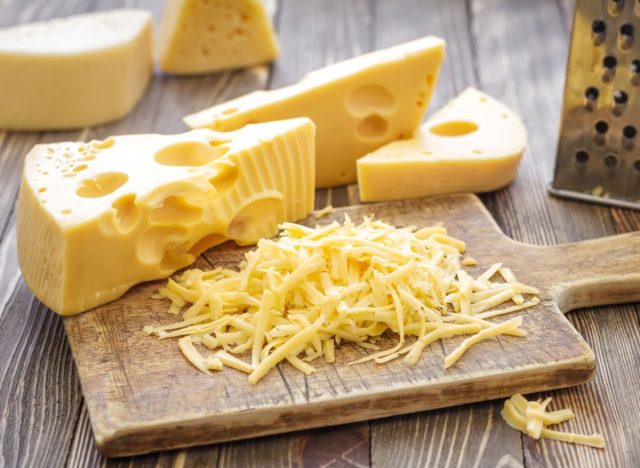
Calories: 86
Fat: 7 g (Saturated Fat: 4 g)
Sodium: 40 mg
Carbs: <1 g (Fiber: 0 g, Sugar: 0 g)
Protein: 6 g
Whether you're making a Rueben sandwich, a Swiss melt, or just need some tasty slices of cheese for your charcuterie board, Swiss is a fantastic low-fat cheese to pick when you want to save on calories but still want a flavorful option. With 7 grams of fat per slice and 4 grams of saturated fat, you can keep your fat intake on the lower end when you add this to your lunch sandwich.
Parmesan (Reduced-Fat)
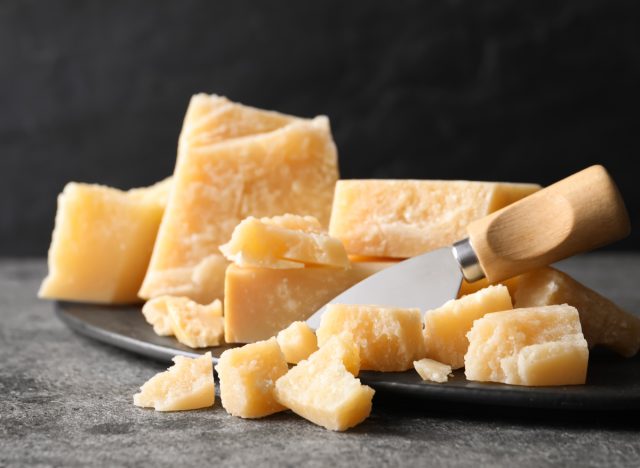
Calories: 75
Fat: 6 g (Saturated Fat: 4 g)
Sodium: 434 mg
Carbs: <1 g (Fiber: 0 g, Sugar: 0 g)
Protein: 6 g
Whether you're grating fresh parmesan onto pasta, salad, or a pizza, you can enjoy the reduced-fat version and keep your total fat intake at around just 6 grams.
Monterey (Reduced-Fat)
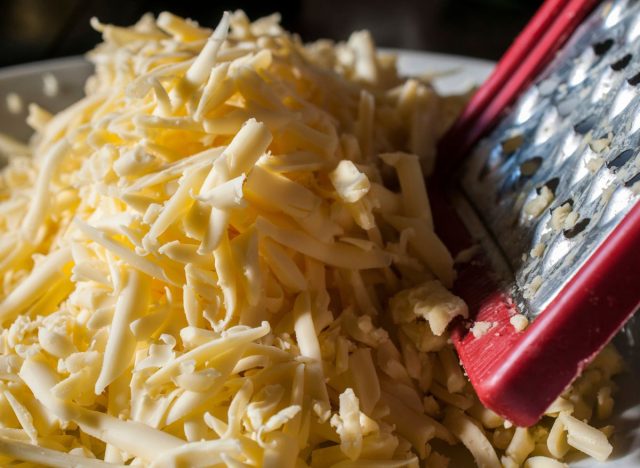
Calories: 88
Fat: 6 g (Saturated Fat: 4 g)
Sodium: 219 mg
Carbs: <1 g (Fiber: 0 g, Sugar: <1 g)
Protein: 8 g
A mild white cheese made from cow's milk, Monterey Jack has only 6 grams of fat per 1-ounce serving. You can eat slices of this semi-hard cheese on crackers or grate it into homemade mac and cheese. However you choose to enjoy this low-fat cheese, you can use it as a way to stick to your health goals.
Mozzarella (Part-Skim)
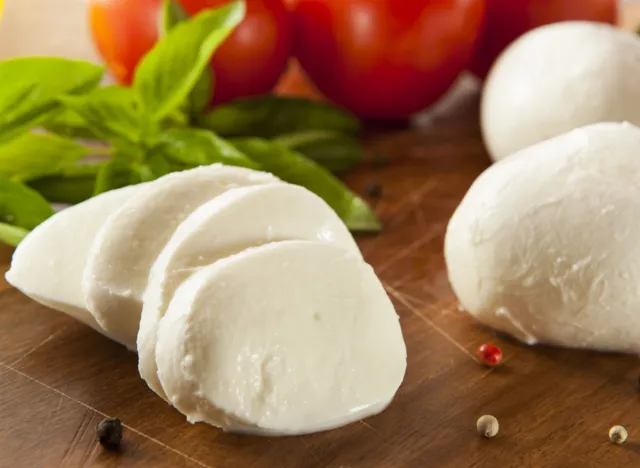
Calories: 72
Fat: 5 g (Saturated Fat: 3 g)
Sodium: 175 mg
Carbs: <1 g (Fiber: 0 g, Sugar: <1 g)
Protein: 7 g
Eating part-skim mozzarella will help keep your fat intake on the lower end but you'll still have the mild flavor and texture you love from regular mozzarella. Enjoy this reduced-fat cheese on a homemade pizza or Caprese salad.
Muenster (Reduced-Fat)
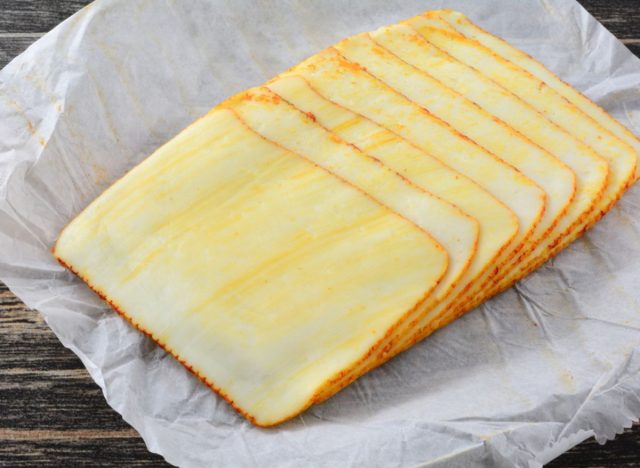
Calories: 76
Fat: 5 g (Saturated Fat: 3 g)
Sodium: 168 mg
Carbs: 1 g (Fiber: 0 g, Sugar: 1 g)
Protein: 7 g
Muenster is a soft, creamy cheese that works great on a regular deli sandwich or as part of a grilled cheese when you need a flavorful cheese that can melt easily. You're only getting 5 grams of fat in one slice, so even if you indulge in a couple of slices, you'll still be able to keep your fat intake fairly low.
Provolone (Reduced-Fat)
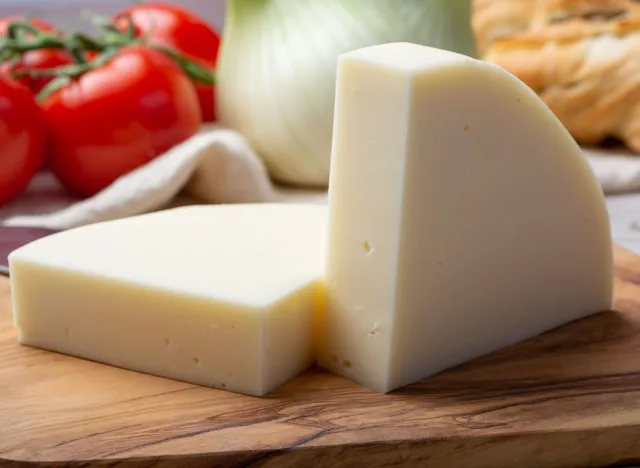
Calories: 77
Fat: 5 g (Saturated Fat: 3 g)
Sodium: 172 mg
Carbs: 1 g (Fiber: 0 g, Sugar: <1 g)
Protein: 7 g
Provolone is a lower-fat cheese (especially if you buy a reduced-fat version) that is super versatile because of its mild flavor and semi-firm texture. It can still melt, so it works great in grilled cheese, mac and cheese, or pasta dishes, but it's also firm enough to be paired with crackers on a charcuterie board or in a sandwich.
Mexican Blend (Reduced-Fat)
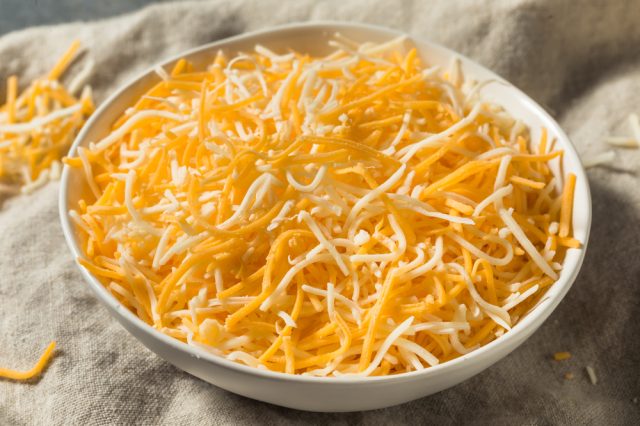
Calories: 79
Fat: 5 g (Saturated Fat: 3 g)
Sodium: 217 mg
Carbs: 1 g (Fiber: 0 g, Sugar: <1 g)
Protein: 7 g
Mexican cheese blends are normally made with Monterey jack, cheddar, queso quesadilla, and asadero cheese, but this can vary depending on the brand. Even though it contains four different cheeses, this blend remains a low-fat cheese option with only around 5 grams per 1/4 cup serving.
Cheddar (Reduced-Fat)
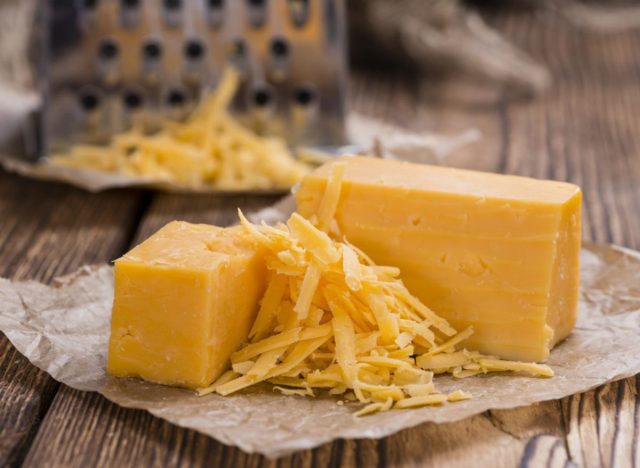
Calories: 49
Fat: 2 g (Saturated Fat: 1 g)
Sodium: 247 mg
Carbs: <1 g (Fiber: 0 g, Sugar: <1 g)
Protein: 7 g
Reduced-fat cheddar is one of the lowest-fat cheeses available on the market. Most servings of low-fat cheddar contain only 2 grams of total fat and 1 gram of saturated, while still providing 7 grams of protein per serving.
Cottage Cheese (1%)
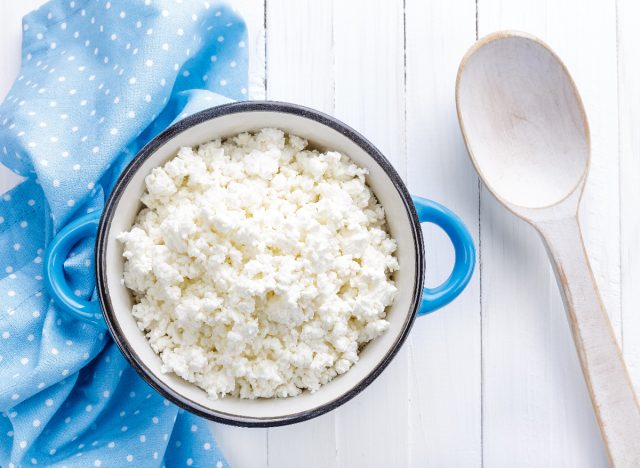
Calories: 81
Fat: 1 g (Saturated Fat: <1 g)
Sodium: 459 mg
Carbs: 3 g (Fiber: 0 g, Sugar: 3 g)
Protein: 14 g
You can't beat cottage cheese's high-protein, low-fat content. Not only is it a super healthy cheese option, but it's also versatile—you can eat a bowlful of fruit or blend it up and make cottage cheese ice cream.
This story has been updated to include new information, fact-checking, and copyedits.
- Source: https://www.sciencedirect.com/topics/food-science/low-fat-cheese
- Source: https://pubmed.ncbi.nlm.nih.gov/23297844/
- Source: https://fdc.nal.usda.gov/fdc-app.html#/food-details/171247/nutrients
- Source: https://fdc.nal.usda.gov/fdc-app.html#/food-details/171248/nutrients
- Source: https://fdc.nal.usda.gov/fdc-app.html#/food-details/746767/nutrients
- Source: https://fdc.nal.usda.gov/fdc-app.html#/food-details/173452/nutrients
- Source: https://fdc.nal.usda.gov/fdc-app.html#/food-details/168098/nutrients
- Source: https://fdc.nal.usda.gov/fdc-app.html#/food-details/170847/nutrients
- Source: https://fdc.nal.usda.gov/fdc-app.html#/food-details/172215/nutrients
- Source: https://fdc.nal.usda.gov/fdc-app.html#/food-details/172216/nutrients
- Source: https://fdc.nal.usda.gov/fdc-app.html#/food-details/173439/nutrients









